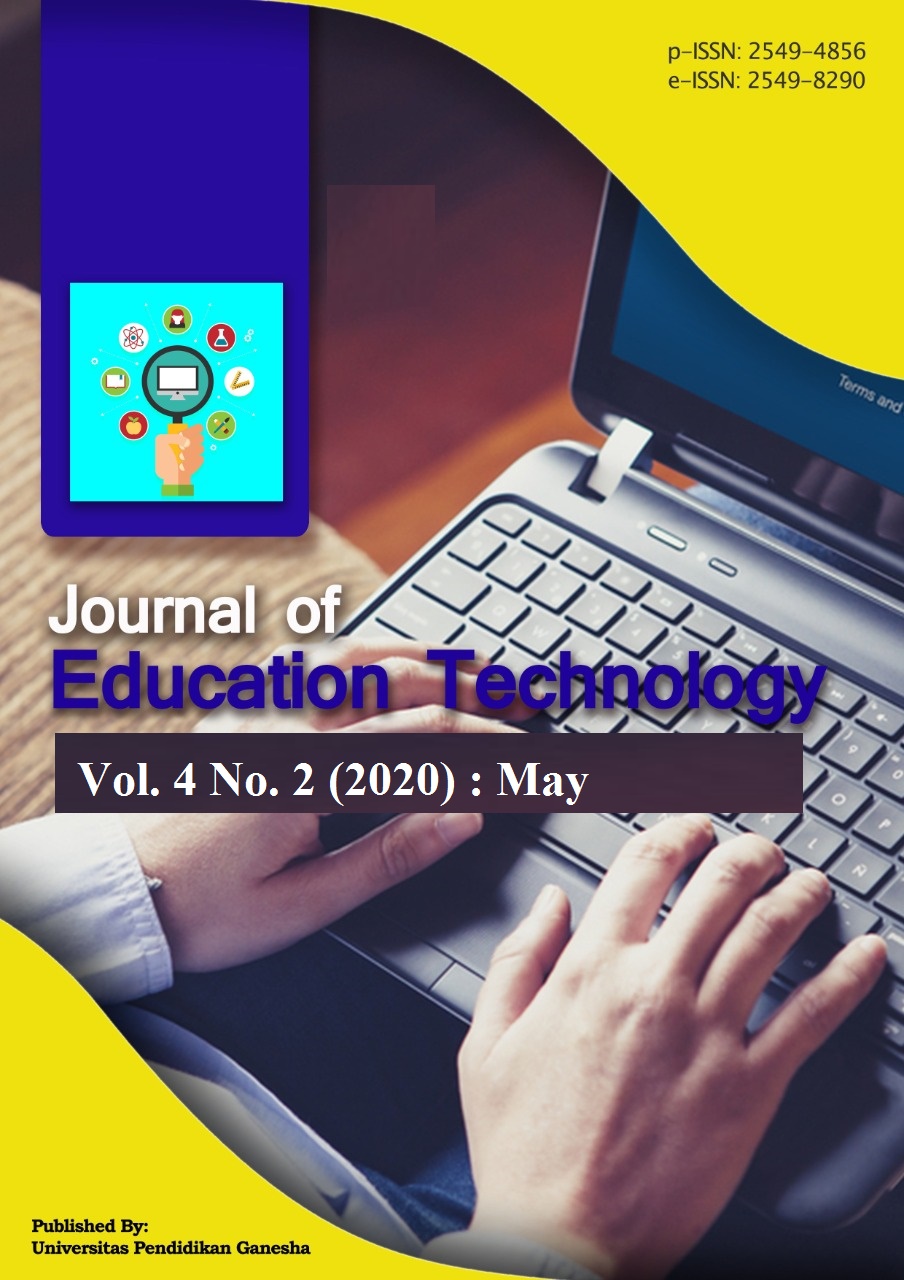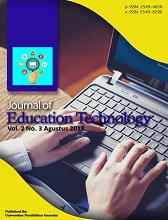Efektivitas Model OPPEMEI untuk Meningkatkan Kemampuan Berpikir Kreatif Mahasiswa
DOI:
https://doi.org/10.23887/jet.v4i2.25343Keywords:
Creative thinking, OPPEMEI, studentsAbstract
The purpose of this research was to improve the students’ creativity and learning outcomes in basic natural science concept course in PGSD Department by using OPPEMEI, it was a new learning model consisted with the steps of learning, such as the orientation, exploration, research, elaboration, exhibition, and implementation. This research used a qualitative descriptive analysis. The subjects of this research were 4 classes (classes F, G, B, and A). Data collection method used creative thinking skills tests with indicators of creative thinking ability which was consisted of fluency, flexibility, elaboration, and originality. Creative thinking skill ability improvement was analyzed by using N-gain. The results showed that there was an improvement in average score of N-gains from the creative thinking skills in the amount of 0.27, 0.153 and 0.101, an improvement occurred in class F. The highest indicator of creative thinking skills was fluency of N-gain in the amount of 0.67. It was categorized into very high criteria. This research showed that the OPPEMEI learning model improved the creative thinking skill ability which would affect the students’ learning outcomes. OPEMEI model would be one of the solutions in the learning process especially in the use of learning models.
References
Adele L. Schmidt, (2010). The Battle for creativity: Frontier in science and science education. Bioessays 32: 1016-1019.Anderson, dkk. (Eds) A Taxonomy of Learning, Teaching, and Assessing, Revision of Bloom’s Taxonomy of Educationnal Objectivees, New York: Longman.
Agustiana. T. I G.A. (2015). Model Pembelajaran Opemes dalam meningkatkan Keterampilan Berpikir Kreatif Mahasiswa PGSD. Makalah. Diselenggarakan Program Studi Pendidikan Sains Program Pascasarjana Universitas Negeri Surabaya. Surabaya: Prosiding Seminar Nasional Pendidikan Sains. ISBN: 978-602-72071-0-3. Hal. 1423-1433.
Agustiana. T. I G.A, Rudiana Agustini), Muslimin Ibrahim (2015) Effect Of Brain Based Learning Model To Ability Of Concepts And Creative Thinking Skills For Students Base On Ability Of Science For Student Of Department Elementary School Of Education” in Proceeding “ ICIRAD The 1 st International Covferencence On Innovative Research Across Disciplines 2015, Kuta Bali Nopember 18-19 th , 2015.
Akkuzu, N. & Uyulgan, M.A., 2016. An epistemological inquiry into organic chemistry education: exploration of undergraduate students’ conceptual understanding of functional groups. Chem. Educ. Res. Pract., 17(1), pp.36–57. Available at: http://xlink.rsc.org/?DOI=C5RP00128E.
Amabile, T. M., & Hennessey, B. A. (1992). The motivation for creativity in children. Achievement and motivation: A social-developmental perspective, 54-74.
Arends, R. I. 2012. Learning to teach. 9th Edition New York: McGraw-Hill Companies.
Barrouillet, P., 2015. Theories of cognitive development: From Piaget to today. Developmental Review, 38, pp.1-12.
Blass, L., Williams, J. & Robinson, A., 2016. 21st Century Reading 4 : Creative Thinking and Reading with TED Talks. , 20(2), pp.20–22.
Çam, A. & Geban, Ö., 2017. Effectiveness of case-based learning instruction on pre-service teachers’ chemistry motivation and attitudes toward chemistry. Research in Science & Technological Education, 35(1), pp.74–87. Available at: https://www.tandfonline.com/doi/full/10.1080/02635143.2016.1248927.
Casagrand, J. & Semsar, K., 2017. Redesigning a course to help students achieve higher-order cognitive thinking skills: from goals and mechanics to student outcomes. Advances in Physiology Educatio.
Depdiknas, 2005. Rencana Strategis Departemen Pendidikan Nasional Tahun 2005-2009. Jakarta: Depdiknas.
Demontis, D., Walters, R. K., Martin, J., Mattheisen, M., Als, T. D., Agerbo, E., ... & Cerrato, F. (2019). Discovery of the first genome-wide significant risk loci for attention deficit/hyperactivity disorder. Nature genetics, 51(1), 63-75.
Evans, James R. (1991). Creative Thinking in the Decision and Management Sciences. Cincinnati: South-Western Publishing Co.Evertson, C.M. Emmer, E.T & Worsham, M..(2003). Classroom management for elementary teachers,(6th Edition) Boston: Allyn and Bacon. Pp-12-14
Fadillah, A. E. (2013). Stres dan motivasi belajar pada mahasiswa psikologi universitas mulawarman yang sedang menyusun skripsi. E-Journal Psikologi, 1(3), 254-267.
Fang, Z. et al., 2016. National Culture, Creativity, and Productivity: What’s the Relationship with Student Achievement? Creativity Research Journal, 28(4), pp.395–406. Available at: https://www.tandfonline. com/doi/full/10.1080/10400419.2016.1229976.
Gabel, D. (1998). The complexity of chemistry and implications for teaching. International handbook of science education, 1, 233-248.
Gencosman, T., & Doğru, M. (2012). Effect of student teams-achievement divisions technique used in science and technology education on self-efficacy, test anxiety and academic achievement. Journal of Baltic Science Education, 11(1), 43.
Guilford, J.P. (1981). Way beyond the IQ. Creative Education Foundation. ISBN 0930222016
Haack, J.A. & Hutchison, J.E., 2016. Green Chemistry Education: 25 Years of Progress and 25 Years Ahead. ACS Sustainable Chemistry & Engineering, 4(11), pp.5889–5896. Available at: http://pubs.acs.org/doi/abs/10.1021/acssuschemeng.6b02069.
Hagger, M.S. & Chatzisarantis, N.L.D., 2016. The Trans-Contextual Model of Autonomous Motivation in Education: Conceptual and Empirical Issues and Meta-Analysis. Review of Educational Research, 86(2), pp.360–407. Available at: http://rer.sagepub.com/cgi/doi/10.3102/0034654315585005.
Hasirci, D., & Demirkan, H. (2003). Creativity in Learning Environments: The Case of Two Sixth Grade Art‐Rooms. The Journal of Creative Behavior, 37(1), 17-41.
Hawkes, G. (1996). Sociology of sex and sexuality. McGraw-Hill Education (UK).
Chou, C. T., & Fu, L. C. (2007). Ships on real-time rendering dynamic ocean applied in 6-dof platform motion simulator. In CACS International Conference (Vol. 3, No. 7).
Jatmiko, B., Prahani, B. K., Munasir, S., Wicaksono, I., Erlina, N., & Pandiangan, P. (2018). The comparison of OR-IPA teaching model and problem based learning model effectiveness to improve critical thinking skills of pre-service physics teachers. Journal of Baltic Science Education, 17(2), 300.
Marinacci, M. (1996). Decomposition and representation of coalitional games. Mathematics of Operations Research, 21(4), 1000-1015.
Munandar Utami. (2009). Pengembangan Kreativitas Anak Berbakat. Jakarta: PT Gramedia Utama.
Peleg, R. et al., 2009. Proof -Teachers’ views on implementing storytelling as a way to motivate inquiry learning in high-school chemistry teaching. Chemistry Education Research and Practice, 24(1), pp.61–65.
Puccio, G. J., Burnett, C., Acar, S., Yudess, J. A., Holinger, M., & Cabra, J. F. (2018). Creative problem solving in small groups: the effects of creativity training on idea generation, solution creativity, and leadership effectiveness. The Journal of Creative Behavior.
Sadler, P. & Sonnert, G., 2016. Understanding Misconceptions - Teaching and Learning in Middle School Physical Science. American Educator, pp.26–32.
Sener, N., & Tas, E. (2017). Developing Achievement Test: A Research for Assessment of 5th Grade Biology Subject. Journal of Education and Learning, 6(2), 254-271.
Suyidno, N. M., Yuanita, L., Prahani, BK, and Jatmiko, B.(2018). Effectiveness of creative responsibility based teaching (CRBT) model on basic physics learning to increase student’s scientific creativity and responsibility. Journal of Baltic Science Education, 17(1), 136-151.
Suzan,Z., Nana Kohn, Pao.K., Friedman, 2013, Critical Thinking of Registereed Nurses, in a Fellowship Program, The Journal of Continuing Education in Nursing Vol 44, No. 8.
Talanquer, V., 2013. Chemistry education: Ten facets to shape Us. Journal of Chemical Education, 90(7), pp.832–838.
Thomas, Cl, 1993, Taber’s Cyclopedia Medical, Dictionary, Phildelpia,: F.A.Davis
Thompson, V. A., Turner, J. A. P., & Pennycook, G. (2011). Intuition, reason, and metacognition. Cognitive psychology, 63(3), 107-140.
Thompson, G., & Bennett, J. (2013). Science teaching and learning activities and students' engagement in science. International Journal of Science Education, 35(8), 1325-1343.
Wahyuni, A. (2017). Analisis Hambatan Belajar Mahasiswa Pada Mata Kuliah Kalkulus Dasar. JNPM (Jurnal Nasional Pendidikan Matematika), 1(1), 10-23.
Yu, M.-L., Brown, T. & Farnworth, L., 2017. Embracing international students in occupational therapy higher education in Australia: Challenge or asset? Australian Occupational Therapy Journal, (March). Available at: http://doi.wiley.com/10.1111/1440-1630.12389.
Yuriev, E., Capuano, B. & Short, J.L., 2016. Crossword puzzles for chemistry education: learning goals beyond vocabulary. Chem. Educ. Res. Pract., 17(3), pp.532–554. Available at: http://xlink.rsc.org/?DOI= C6RP00018E.
Downloads
Published
How to Cite
Issue
Section
License
Authors who publish with the Journal of Education Technology agree to the following terms:
- Authors retain copyright and grant the journal the right of first publication with the work simultaneously licensed under a Creative Commons Attribution License (CC BY-SA 4.0) that allows others to share the work with an acknowledgment of the work's authorship and initial publication in this journal.
- Authors are able to enter into separate, additional contractual arrangements for the non-exclusive distribution of the journal's published version of the work (e.g., post it to an institutional repository or publish it in a book), with an acknowledgment of its initial publication in this journal.
- Authors are permitted and encouraged to post their work online (e.g., in institutional repositories or on their website) prior to and during the submission process, as it can lead to productive exchanges, as well as earlier and greater citation of published work. (See The Effect of Open Access)


















